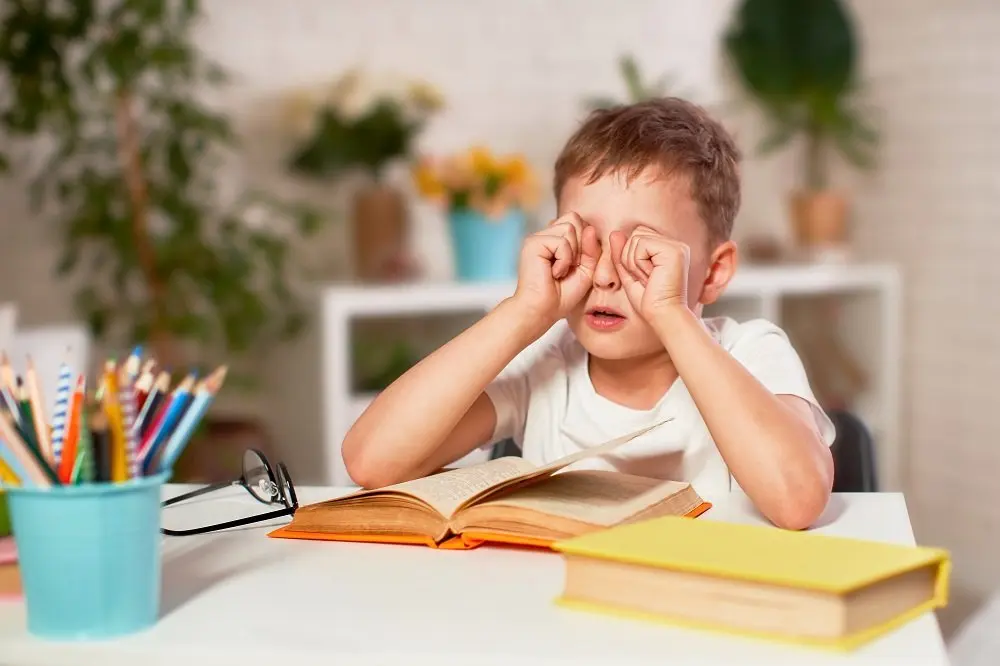Table of Content
Struggling with your vision and not sure what’s causing it? Let’s explore eye strain, why it happens, and what you can expect from this common ailment.
What Is Eye Strain?
The answer to the question “what is eye strain?” is not as clear-cut as you may think. Eye strain is a term that covers several symptoms, but which all involve the straining of the eye and a negative impact on a person’s vision. It includes eye fatigue and digital eye strain and often makes it difficult for a person to read books, drive long-distance, or perform other visual tasks.
Everyone experiences eye strain differently, and the problem can be triggered by several daily activities. To understand the condition and to know whether it’s affecting you, it’s important to know the symptoms. So, let’s take a look at some of the signs of eye strain.
Eye Strain Facts
There are a few things to keep in mind when discussing eye strain, or asthenopia.
- Eye strain occurs when the eyes are used for extended periods of time.
- Though unpleasant, it does not result in any permanent eye damage.
- There are different types of eye strain, like digital or anxiety eye strain, and knowing the cause can help with prevention.

Eye Strain Symptoms
Eye strain can affect everybody differently, but it always includes one or more of the following symptoms.
- Nausea
- Neck, back, or shoulder pain
- Painful or irritated eyes
- Dry eyes
- Watery eyes
- Blurred vision
- Double vision
- Light sensitivity
- Difficulty focusing on tasks
- Difficulty reading
If you’re suffering from eye strain in one eye or both, you will experience one or more of these symptoms for prolonged periods. These eye strain symptoms may also appear only when you perform specific visual tasks, which is another sign your problem is, in fact, eye strain.
However, the American Optometric Association showed that the most common symptom you should expect from eye strain is dry eye, headaches, and blurred vision.
Precisely because these symptoms are caused by eye strain, you should expect to also experience eye strain nausea as well. The only way to stop these symptoms in their tracks is to stop performing the visual tasks that cause them, take precautions for the future, or see a specialist eye doctor to help you avoid eye fatigue in the future.
Eye Strain Causes
There are multiple eye strain causes to take a look at, but it’s important to note that the most common reason why Americans suffer eye fatigue today is the use of smartphones and computers.
A 2015 study found that 58% of American adults have experienced eye strain and vision problems as a result of using computers for more than seven hours a day at home or at work.
However, there’s more to it. Eye strain can be caused by any of the following things:
- Exposure to dry air indoors, caused by HVAC units
- General fatigue and stress that makes you unable to focus
- Underlying eye problems, including uncorrected refractive errors
- Long exposure to digital screens
- Reading for long periods
- Long-distance driving
When it comes to computers, bad posture while sitting at your desk or glare on your screen can also make the symptoms worse.

Computer and Digital Device Use
In this digital age, computers, tablets, phones, and many other devices are the common culprits for eye strain. There are a few reasons why digital eye strain occurs:
- Blinking less often when looking at a screen than otherwise.
- Holding a device too close or too far from one’s eyes.
- Extended exposure to blue light.
- Improperly adjusted lighting on the screen.
- Poor posture while sitting in front of a screen.
Learn more about preventative measures to protect against digital eye strain.
Eye Strain Relief
Before you reach the treatment stage, eye strain relief methods can be used to reduce strain and make you more comfortable.
You can relieve eye strain with these three simple methods.
- Rest your eyes
- Improve your air quality
- Wear the right eyeglasses prescription
Resting your eyes is essential. Take regular breaks and get a good night’s sleep and make sure your eyes are prepared to function for a long day of work.
When it comes to air quality, you should do all you can to avoid dry air. If possible, avoid using an air conditioner and open the window instead. Use a humidifier if the air is particularly dry, and move away from irritants like smoke.
Finally, remember to get your eyes checked frequently and ensure you’re wearing the right prescription. If you don’t wear glasses, now’s the time to find out if you need them!
Diagnosis of Eye Strain
Visit your eye doctor or specialist to receive a diagnosis of eye strain. During this appointment, your physician will request information on your symptoms, including when they occur and how frequently. Most likely, your healthcare provider will do a physical exam to check for refractive errors, muscle imbalances, and any other possible potential issues with your eyes. Generally, eye strain pain will recede on its own, without the need for medical intervention.
Other conditions can cause the same symptoms like eye strain like nausea, dizziness, or eye pain. These conditions include tension fatigue, headaches, migraines, and viral conjunctivitis, also known as pink eye.

Eye Strain Treatment
Eye strain is best combated through preventative measures, but there are treatments available for people who take these measures and use eye strain remedies but still suffer.
Your eye strain treatment process starts with speaking to an eye doctor to test your vision and perform a full eye exam.
From here, you may be diagnosed with an underlying eye problem, instructed to use over-the-counter artificial tears, or prescribed medicated eye drops to help relieve your symptoms. But first, we always recommend you reduce eye strain by changing your environment.
Another helpful remedy to try at home is artificial tears. There are many varieties of artificial tears available over the counter that are cost-effective and easy to use. While it may not alleviate your discomfort completely, these lubricating eye drops are certainly worth trying as part of self-care.
Eye Strain Prevention Tips
20-20-20 Rule
Balance is everything! Eye strain is commonly caused by doing the same thing for too long with no break. One solution is eye strain exercises like the 20-20-20 rule. Focus on something, other than your current task, that is 20 feet away for 20 seconds every 20 minutes.
Move Your Screen
Your smartphone, computer, tablet, or any other device might be too close or too far away from you, causing eye strain. Move the device to be about an arm’s length away from your face and make sure it’s at or below eye level.
Find Good Lighting
The best monitor for eye strain is simply one that you adjust to accommodate for lighting and glare. Room lighting is also important. Adjust lights as needed like dimming lights during a movie or ensuring that the light is coming from behind you when you’re reading.
Multitask Carefully
Multitasking at work is common, but looking back and forth between a screen and a piece of paper can be painful for your eyes, neck, and head. Getting a document stand to put between your keyboard and monitor can help prevent eye strain.
Eye Drops
We tend to blink less while looking at a screen, or even just while we’re focusing very intensely on something. This can often cause red, dry, and irritated eyes. The easiest solution is to use eye drops for eye strain, which simulate tears.

Check Your Air
Poor air quality can be very detrimental to your eyes. Rooms with fans or heating and cooling units, as well as polluted environments can cause eye strain. Consider getting a humidifier, turning down the heating or cooling, or even just relocating to a room with better air quality.
Wear Proper Eyewear
Your eye specialist can recommend special eyewear to help reduce strain. They might suggest anything from eye strain glasses to reducing contact lens use. There are also coatings and tints on certain lenses that can help with eye strain.
Vary Your Focus
The best and most effective way to reduce eye strain is to vary your activities. We tend to focus on things for extended periods of time due to the 8-hour workday. However, taking regular breaks and reducing time spent on devices can be a great solution.
Risk Factors for Eye Strain
Eye strain can affect anyone, both children and adults. There are risk factors that make someone more likely to get eye strain, like existing refractive errors, nearsightedness, farsightedness, and astigmatism. Other risk factors include chronic dry eyes, eye muscle issues, extended exposure to screens, and reading for very long periods of time.
See an Eye Specialist in Chicago Today!
Eye strain is often caused by environmental factors, but it can also be a result of an underlying condition.
For clarity and relief from painful eye strain symptoms, don’t hesitate to call the Kraff Eye Institute today. Our world-class doctors and eye care specialists provide full exams, accurate diagnoses, and treatments that restore your eye health.
Call today at (312) 444-1111 or schedule your appointment online.
FAQ
What is eye strain a symptom of?

Eye strain may be a symptom of an underlying eye condition but is typically caused by long exposure to digital screens or long-distance driving.
Can you get migraines from eye strain?

Yes, headaches and migraines are common symptoms of eye strain.
What does an eye strain headache feel like?

Eye strain headaches manifest themselves as thumping, dull pains towards the front of the head, but they can vary greatly from person to person.
Do glasses help with eye strain?

Glasses often solve eye strain for people who did not realize they needed a prescription.
Is eye strain dangerous?

While eye strain doesn’t necessarily cause long-term damage, symptoms can get gradually worse if not treated.
Will eye strain go away?

Yes, but will likely return when re-exposed to the environmental triggers that caused the pain in the first place.

















